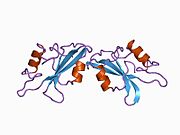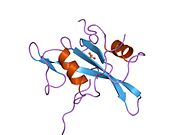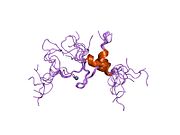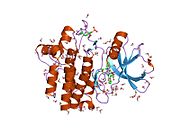Lck
This article needs additional citations for verification. (April 2012) |
Ensembl | |||||||||
|---|---|---|---|---|---|---|---|---|---|
| UniProt | |||||||||
| RefSeq (mRNA) | |||||||||
| RefSeq (protein) | |||||||||
| Location (UCSC) | Chr 1: 32.25 – 32.29 Mb | Chr 4: 129.44 – 129.47 Mb | |||||||
| PubMed search | [3] | [4] | |||||||
| View/Edit Human | View/Edit Mouse |
Lck (or lymphocyte-specific protein tyrosine kinase) is a 56
Lck is responsible for the initiation of the TCR signaling cascade inside the cell by phosphorylating immunoreceptor tyrosine-based activation motifs (ITAM) within the TCR-associated chains.
Lck can be found in different forms in immune cells: free in the cytosol or bound to the plasma membrane (PM) through myristoylation and palmitoylation. Due to the presence of the conserved CxxC motif (C20 and C23) in the zinc clasp structure, Lck is able to bind the cell surface coreceptors CD8 and\or CD4.
Bound and free Lck have different properties: free Lck has more pronounced kinase activity in comparison to bound Lck, and moreover, the free form produces a higher level of T cell activation.[6] The reasons for these differences are not well understood yet.
T cell signaling
Lck is most commonly found in
There are two main pools of T cells which mediate adaptive immune responses: CD4+ T cells (or helper T cells), and CD8+ T-cells (or cytotoxic T cells) which are MHCII-and MHCI restricted respectively. Despite their role in the immune system is different their activation is similar. Cytotoxic T cells are directly involved in the individuation and in the removal of infected cells, whereas helper T cells modulate other immune cells to supply the response.[10]
The initiation of immune response takes place when T cells encounter and recognize their cognate antigen. The
The function of Lck has been studied using several biochemical methods, including
Lck activity regulation
The activity of the Lck can be positively or negatively regulated by the presence of other proteins such as the membrane protein CD146, the transmembrane tyrosine phosphatase CD45 and C-terminal Src kinase (Csk). In mice, CD146 directly interacts with the SH3 domain of coreceptor-free LCK via its cytoplasmic domain, promoting the LCK autophosphorylation.[16] There is very little understanding of the role of CD45 isoforms, it is known that they are cell type-specific, and that they depend on the state of activation and differentiation of cells. In naïve T cells in humans, CD45RA isoform is more frequent, whereas when cells are activated the CD45R0 isoform is expressed in higher concentrations. Mice express low levels of high molecular weight isoforms (CD45RABC) in thymocytes or peripheral T cells. Low levels of CD45RB are typical in primed cells, while high levels of CD45RB are found in both naïve and primed cells.[17] In general, CD45 acts to promote the active form of LCK by dephosphorylating a tyrosine (Y192) in its inhibitory C-terminal tail. The consequent trans-autophosphorylation of the tyrosine in the lck activation loop (Y394), stabilizes its active form promoting its open conformation[18] which further enhances the kinase activity and substrate binding. The Dephosphorylation of the Y394 site can also be regulated by SH2 domain-containing phosphatase 1 (SHP-1), PEST-domain enriched tyrosine phosphatase (PEP), and protein tyrosine phosphatase-PEST.[6] In contrast, Csk has an opposite role to that of CD45, it phosphorylated the Y505 of Lck promoting the closed conformation with inhibited kinase activity. When both Y394 and Y505 are unphosphorylated the lck show a basal kinase activity, vice versa, when phosphorylated, lck show similar activity to the Y394 single phosphorylated Lck [6]
Structure
Lck is a 56-
Lck and disease
Mutations in Lck are liked to a various range of diseases such as SCID (Severe combined immunodeficiency) or CIDs. In these pathologies, the dysfunctional activation of the lck leads to T cell activation failure. Many pathologies are linked to the overexpression of Lck such as cancer, asthma, diabetes 1, rheumatoid arthritis, psoriasis, systemic lupus erythematosus, inflammatory bowel diseases (Crohn's disease and ulcerative colitis), organ graft rejection, atherosclerosis, hypersensitivity reactions, polyarthritis, dermatomyositis. The increase of the lck in colonic epithelial cells can lead to colorectal cancer. The lck play a role also in the Thymoma, an auto-immune disorder which involve thymus. Tumorigenesis is enhanced by abnormal proliferation of immature thymocytes due to low levels of Lck.[19]
Lymphoid protein tyrosine phosphatase (lyp), is one of the suppressor of lck activity and mutations in this protein are correlated with the onset of diabetes 1. Increased activity of lck promote the onset of the diabetes 1.
Regarding respiratory diseases, asthma is associated with the activation of th2 type of t cell whose differentiation is mediated by lck.[20] Moreover, mice with an unbalanced amount of lck show altered lung function which can consequentially leads to the onset of asthma. [21]
Substrates
Lck tyrosine phosphorylates a number of proteins, the most important of which are the
Inhibition
In resting T cells, Lck is constitutively inhibited by Csk phosphorylation on tyrosine 505. Lck is also inhibited by
Saractinib, a specific inhibitor of LCK impairs maintenance of human T-ALL cells in vitro as well as in vivo by targeting this tyrosine kinase in cells displaying high level of lipid rafts.[23]
Masitinib also inhibits Lck, which may have some impact on its therapeutic effects in canine mastocytoma.[24]
HSP90 inhibitor NVP-BEP800 has been described to affect stability of the LCK kinase and growth of T-cell acute lymphoblastic leukemias.[25]
Interactions
Lck has been shown to
See also
References
- ^ a b c GRCh38: Ensembl release 89: ENSG00000182866 – Ensembl, May 2017
- ^ a b c GRCm38: Ensembl release 89: ENSMUSG00000000409 – Ensembl, May 2017
- ^ "Human PubMed Reference:". National Center for Biotechnology Information, U.S. National Library of Medicine.
- ^ "Mouse PubMed Reference:". National Center for Biotechnology Information, U.S. National Library of Medicine.
- PMID 27271569.
- ^ PMID 32571924.
- PMID 2455897.
- PMID 2470098.
- PMID 16966372.
- PMID 32023465.
- ^ Janeway C (2012). "Chapter 7: Lymphocyte Receptor Signaling". janeway's immunobiology 8th edition. New York: Garland Science. p. 268.
- PMID 12732664.
- PMID 18660530.
- PMID 31611699.
- PMID 26888964.
- PMID 34491908.
- PMID 15302847.
- PMID 31641081.
- S2CID 53111664.
- PMID 20237292.
- PMID 12021241.
- PMID 11904433.
- S2CID 3833020.
- PMID 26021891.
- PMID 33737511.
- PMID 11741929.
- PMID 8551220.
- PMID 8576267.
- PMID 9573028.
- PMID 12007789.
- PMID 11854499.
- PMID 8910285.
- PMID 9341123.
- ^ PMID 14583609.
- PMID 8246987.
- PMID 10617656.
- PMID 11294838.
- PMID 8114715.
- PMID 8473339.
- PMID 8576115.
- PMID 14757743.
- ^ PMID 7539035.
- PMID 10449731.
- PMID 10318843.
Further reading
- Sasaoka T, Kobayashi M (August 2000). "The functional significance of Shc in insulin signaling as a substrate of the insulin receptor". Endocrine Journal. 47 (4): 373–381. PMID 11075717.
- Goldmann WH (2003). "p56(lck) Controls phosphorylation of filamin (ABP-280) and regulates focal adhesion kinase (pp125(FAK))". Cell Biology International. 26 (6): 567–571. S2CID 86450727.
- Mustelin T, Taskén K (April 2003). "Positive and negative regulation of T-cell activation through kinases and phosphatases". The Biochemical Journal. 371 (Pt 1): 15–27. PMID 12485116.
- Zamoyska R, Basson A, Filby A, Legname G, Lovatt M, Seddon B (February 2003). "The influence of the src-family kinases, Lck and Fyn, on T cell differentiation, survival and activation". Immunological Reviews. 191: 107–118. S2CID 10156186.
- Summy JM, Gallick GE (December 2003). "Src family kinases in tumor progression and metastasis". Cancer and Metastasis Reviews. 22 (4): 337–358. S2CID 12380282.
- Leavitt SA, SchOn A, Klein JC, Manjappara U, Chaiken IM, Freire E (February 2004). "Interactions of HIV-1 proteins gp120 and Nef with cellular partners define a novel allosteric paradigm". Current Protein & Peptide Science. 5 (1): 1–8. PMID 14965316.
- Tolstrup M, Ostergaard L, Laursen AL, Pedersen SF, Duch M (April 2004). "HIV/SIV escape from immune surveillance: focus on Nef". Current HIV Research. 2 (2): 141–151. PMID 15078178.
- Palacios EH, Weiss A (October 2004). "Function of the Src-family kinases, Lck and Fyn, in T-cell development and activation". Oncogene. 23 (48): 7990–8000. S2CID 20109652.
- Joseph AM, Kumar M, Mitra D (January 2005). "Nef: "necessary and enforcing factor" in HIV infection". Current HIV Research. 3 (1): 87–94. PMID 15638726.
- Levinson AD, Oppermann H, Levintow L, Varmus HE, Bishop JM (October 1978). "Evidence that the transforming gene of avian sarcoma virus encodes a protein kinase associated with a phosphoprotein". Cell. 15 (2): 561–572. S2CID 40461709.
- Thomas PM, Samelson LE (June 1992). "The glycophosphatidylinositol-anchored Thy-1 molecule interacts with the p60fyn protein tyrosine kinase in T cells". The Journal of Biological Chemistry. 267 (17): 12317–12322. PMID 1351058.
- Shenoy-Scaria AM, Kwong J, Fujita T, Olszowy MW, Shaw AS, Lublin DM (December 1992). "Signal transduction through decay-accelerating factor. Interaction of glycosyl-phosphatidylinositol anchor and protein tyrosine kinases p56lck and p59fyn 1". Journal of Immunology. 149 (11): 3535–3541. S2CID 23189716.
- Weber JR, Bell GM, Han MY, Pawson T, Imboden JB (August 1992). "Association of the tyrosine kinase LCK with phospholipase C-gamma 1 after stimulation of the T cell antigen receptor". The Journal of Experimental Medicine. 176 (2): 373–379. PMID 1500851.
- Cefai D, Ferrer M, Serpente N, Idziorek T, Dautry-Varsat A, Debre P, Bismuth G (July 1992). "Internalization of HIV glycoprotein gp120 is associated with down-modulation of membrane CD4 and p56lck together with impairment of T cell activation". Journal of Immunology. 149 (1): 285–294. S2CID 25896387.
- Soula M, Fagard R, Fischer S (February 1992). "Interaction of human immunodeficiency virus glycoprotein 160 with CD4 in Jurkat cells increases p56lck autophosphorylation and kinase activity". International Immunology. 4 (2): 295–299. PMID 1535787.
- Crise B, Rose JK (April 1992). "Human immunodeficiency virus type 1 glycoprotein precursor retains a CD4-p56lck complex in the endoplasmic reticulum". Journal of Virology. 66 (4): 2296–2301. PMID 1548763.
- Molina TJ, Kishihara K, Siderovski DP, van Ewijk W, Narendran A, Timms E, et al. (May 1992). "Profound block in thymocyte development in mice lacking p56lck". Nature. 357 (6374): 161–164. S2CID 4363506.
- Yoshida H, Koga Y, Moroi Y, Kimura G, Nomoto K (February 1992). "The effect of p56lck, a lymphocyte specific protein tyrosine kinase, on the syncytium formation induced by human immunodeficiency virus envelope glycoprotein". International Immunology. 4 (2): 233–242. PMID 1622897.
- Torigoe T, O'Connor R, Santoli D, Reed JC (August 1992). "Interleukin-3 regulates the activity of the LYN protein-tyrosine kinase in myeloid-committed leukemic cell lines". Blood. 80 (3): 617–624. PMID 1638019.
External links
- lck+Kinase at the U.S. National Library of Medicine Medical Subject Headings (MeSH)
- Overview of all the structural information available in the PDB for UniProt: P06239 (Tyrosine-protein kinase Lck) at the PDBe-KB.


























